Ripe, Not Quite, and Not Even Close
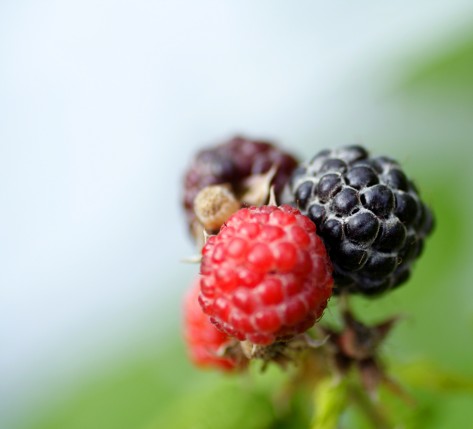
I have some club news—newsier news than the ongoing ebb and flow of members coming and going, and the cycling through of new cookbooks: The Dowdy Corners Cookbook Club will no longer be based out of Dowdy Corners. All else will remain the same: the name (when Steiglitz’s 291 gallery changed address from its location from its original address of 291 Fifth Avenue, he kept the name—so I am too); the growing list of members (Bhakti and Marianne being the most recent to join); and the club’s function—to explore new foods and cooking techniques with a group of likeminded passionate cooks who love cookbooks.
I could stop writing here, and this posting would truly be just an update on club news, and the shortest posting to date. Instead, it may become the longest bit of writing on this blog, except perhaps my posting last year about a trip to France, a place that encourages wordy praise. Aside from poetry, which I do not write, how is it possible to describe the impact of three life-changing years in 500 words or less, the length of a typical blog posting?
****************************************************
The house at Dowdy Corners is a 1940s cape which, being built on an older slate foundation, has a much older feel. From its back deck I could look out onto mountains. I could walk 15 minutes up the dirt road to Jerry and Miriam Kill’s dairy farm where I routinely bought raw milk. At the new DCCC home base, a large Victorian located in town, I enjoy views of other Victorian homes from a front porch and see (and hear) lots of street life: neighbors walking their dogs, children playing, and the token town crazy guy, who rides his bicycle through the neighborhood every morning singing a personal, indecipherable song.
It is a fitting coincidence that this summer’s DCCC pick is Ripe by Nigel Slater, a book devoted to the pleasures of growing, preparing, and eating fruit. At Dowdy Corners it was the first season of relative abundance in our nascent berry patch, not counting the gooseberries which we planted just two years ago and will probably not bear fruit until next year.
Taking breaks from packing, I picked small amounts of berries at a time, getting blue-black stained fingers from the ripest of large, plump black raspberries. The red currants shown like cut rubies when the mid-morning light hit them at the just-right angle; whereas the black currants remained dusky and mysterious. My biggest harvest was from the blueberry and black currant bushes, which I squirreled away in the freezer for use later when my new kitchen would be assembled. (I believe I will have just enough single-origin “Dowdy Corners” black currants to make Slater’s recipe for black currants under an oat and almond crust and enough blueberries to make his blueberry batter pudding, a riff on the French clafoutis.)
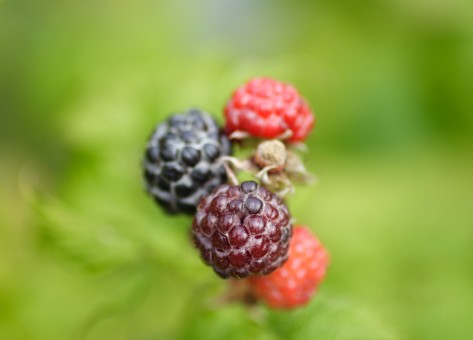
Pequot black raspberry

Red Lake red currant
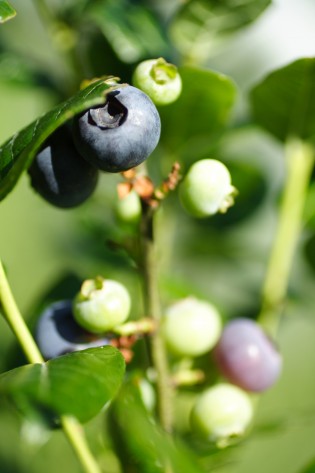
Bluegold blueberry
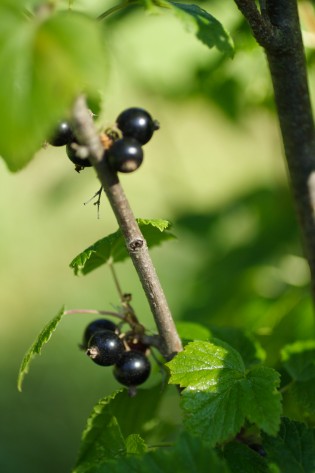
Titania black currant
There’s something so pleasurable, so natural, and even ancestral about picking fruit and eating it on the spot. There you are milling about on a sunny day, peering under leaves for hidden gems, competing with the birds for the berries on the upper portions of the bush and with the chickens for the berries within chicken-jumping height. One day I saw the tip of our rooster’s beak lipsticked red, and I knew he’d been, like me, enticed by the raspberry bush. (Tomatoes, the only contender in the vegetable garden to rival fruit’s pleasures of eating out of hand, also tempt chickens; Della, my favorite and goofiest hen, would run around with a bright red cherry tomato in her beak, like Rudolph the Red-Nosed Reindeer.)
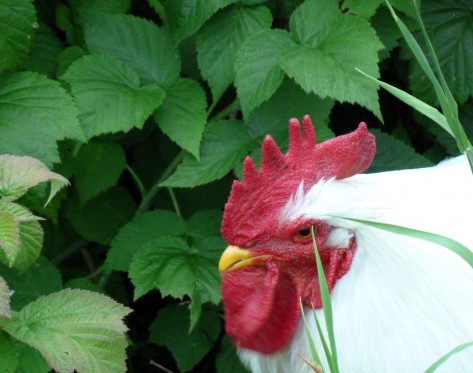
Bob in the red raspberry bush. I wasn’t able to capture his glam look in this photo, but I swear, one day the tip of his beak was stained with the juices of the raspberries.
Having briefly been the steward of Dowdy Corners, I now understand why land ownership has been the ultimate wealth for much of our human history. There is something so luxurious about casually reaching up to pick an apple in early fall or crouch down to a blueberry bush in mid-summer while strolling on your own property. Owning this sort of abundance is an incomparable richness.
The beauty and abundance of the fruit and the blossoms at Dowdy Corners was matched by our small flock of multi-colored and –sized chickens and the eggs they laid nearly daily, ranging in color from white to brown to blue—some solid and some speckled—and in size from 1½ to 3-plus ounces.
Catching sight of our flock, set off against an expanse of green grass or white snow, always brought an irrepressible smile to my lips. My favorite time of day to watch the chickens was early evening when the slanting, rose-tinted light would rake across them. Their combs would appear to glow and an array of colors, hidden at other times of day, would emerge from their feathers. Fagin, an Araucana-cross with Dickenslike tufts on either side of her face, a tell-tale trait of the breed, has mottled black and cream feathers. It was in the light of late evening that I first noticed the startling vibrant turquoise hidden in her plumage.
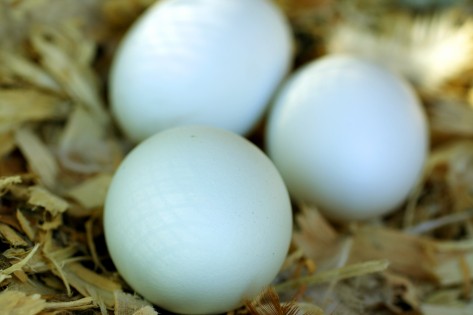
Blueish eggs from our Araucana-crossses
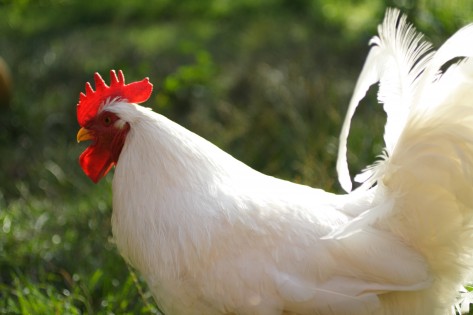
Bob with his comb and wattle illuminated by the evening light
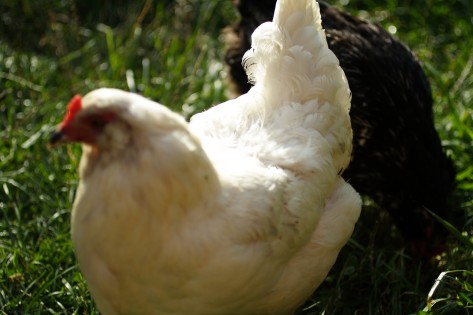
The intricacy of Dodger’s tail feathers highlighted in the evening light
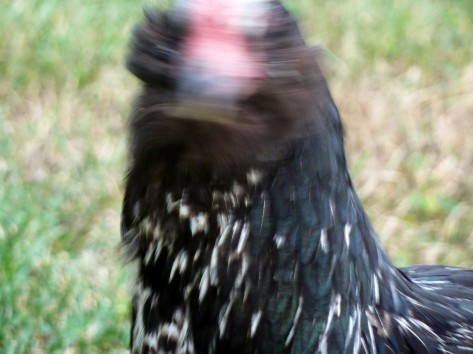
Fagin a la Francis Bacon (the blue in her plummage is just visible in this photo)
The sounds of farm animals bring a rural setting to life. At Dowdy Corners the air was amplified with the buzzing of our honey bees and the clucks of our chickens. Each day would start with Bob the Rooster’s sharp, life-affirming crow, which always seemed to say: “I’m alive! I’m alive! Let’s get the day going! Come on! Come on girls!” With the number of predators a chicken must contend with, it’s not surprising that a rooster would want to announce the start of each day with bravura. Then there was the range of sounds Bob made when communicating with the hens, most often when telling them where to find a choice morsel of food, followed by the hens’ gentle clucking when happily eating. And no chicken yard is complete without the melodramatic squawks a hen makes after laying an egg, followed inevitably by a rooster’s equally melodramatic call-and-response cries of heroic rescue.
It was only after we delivered Bob and his girls to their new home, our friend Jenn’s farm (called Fat Rooster Farm), that I felt truly ready to leave. Emptied of the sight and sounds of the chickens, Dowdy Corners seemed flat, lifeless, and far too quiet. It gave meaning to the expression “empty nest.” Even when the chickens were quiet, asleep in their coop, it was comforting to know they were safe and sound, locked up for the night, sitting on their perch with their heads drooped down, heavy with sleep.
[audio: https://dowdycornerscookbookclub.com/wp-content/uploads/2012/08/Bob-Crowing-in-early-morning_shorter-version.mp3]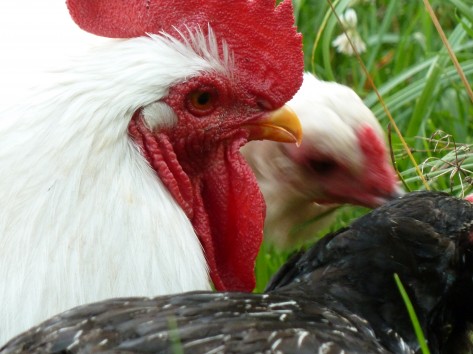
Bob pointing out something good to eat to the hens
Before finding the large Victorian to rent, we had looked at much smaller apartments where there would have been no room for my chest freezer. I panicked. How in just over four weeks, during which time we had to pack, find a place to live, and relocate the chickens and bees, would I have time to cook a chest-freezer full of food, much of it blanched vegetables from the garden or cuts of the half-Berkshire pig we purchased from our friend James.
The first week of frantic eating was a snapshot of DCCC books over the last year or so: we ate gumbo zeb from Dairy Hollow House Cookbook, frijoles de olla (pot beans) from The Art of Mexican Cooking, and samosas from Entice with Spice. Using the banana leaves my Uncle Carl sent me from his backyard in South Carolina and a cut of the Berkshire pork, we made puerco pibil using the method in one of my favorite food videos: Ten Minute Cooking School. Then thankfully the Victorian came through and the frantic eating was replaced by frantic packing.
Three items in the freezer, however, would not make the trip from Dowdy Corners to our new home: the frozen carcasses of two hens—Ginger, whose story can be read here, and Anita, who was hit by a car—and a beautiful cedar waxwing that had broken its neck flying into a window at the house. We buried Ginger, Anita, and the cedar waxwing under the apple tree, one of the favorite spots of the chickens. To the burial hole, we also added feathers of various chickens who had been killed by a fox—a trail of feathers could usually be found where the fox and hauled way its prey into the woods—and we recited the names of Coco and Besse, two hens who disappeared without a trace.
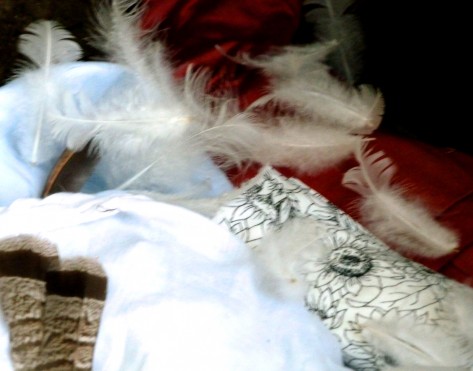
Ginger, Anita, and the cedar waxwing wraped in cloth, and loose feathers from Della and other chickens from our past flocks in the burial hole

Candlelit burial under the apple tree
Mike included Bob #1 in the list of chickens to be remembered, a rooster that had begun to show frightening aggression toward me before his demise. Because of our adversarial relationship, I was actually relieved to see Bob #1 go. And his death taught me something about country burglary.
When living in Brooklyn, my apartment, in an old, not well-secured building, was broken into twice. When I moved to rural Vermont, I assumed I left burglary behind. I hadn’t. It was just a different type of burglary. We had something the fox wanted, and our free-range chickens were easy pickings, as were the goods in my Brooklyn apartment. The thief here is just a little different. I can’t reason with the fox to, say, for example, offer to buy it chicken meat from the store in exchange for sparing our chickens. Then again, I’m not sure I would have been able to convince my Brooklyn burglar not to lift the vintage Rolleiflex camera, a gift from my mother, stored on the bottom shelf of the bookstand in my bedroom, in exchange for something else that I coveted less.
It was then, to avoid more thieveries, that we moved the coop closer to the house, making the cock-a-doodle-doo’s and warning cries of Bob #1’s replacement more audible.
The move from Dowdy Corners is bittersweet. We are leaving behind an enriching and beautiful place while simultaneously being freed of the responsibility of home ownership and land management. There was some bewilderment, after all. What pruning method and trellis construction should I use for the grapes? What is it that I’m supposed to do with the old raspberry canes? And what is a cane, anyway? And is there anything that I need to do for the fruit trees as they’re growing?
I learned it’s easy enough to plant things, lots of things. It’s their maintenance that can be daunting. (The excitement of being a first-time property owner with 6⅓ acres to work with had made me go fruit-berzerk. During the first spring at Dowdy Corners we planted forty-one fruit and nut trees, fruit bushes, and grape vines, and in the following spring we plant six more fruit bushes to replace the Johns, Nova, and York elderberry bushes that were gnawed down to nubs by deer during the winter because we hadn’t properly protected them and to replace the Boyne and Autumn Bliss red raspberry bushes that we improperly planted [we planted them too deep, a common error]).
There are other fruit analogies. Like not seeing everything at Dowdy Corners to fruition. I will not have the pleasure of tasting the grapes—this is the first summer the vines produced bunches of grapes, a tantalizing tease as grapes ripen in late summer, long after our closing date—or any of the fruit from the trees. The trees, unlike the bushes, take even longer to begin bearing, and will probably produce next year at the earliest. Of the ten fruit trees we planted, I was especially looking forward to eating the plums from our Green Gage plum tree—the best variety of plum I’ve ever eaten—and making homemade pies with the sour cherries from our Bali cherry tree.
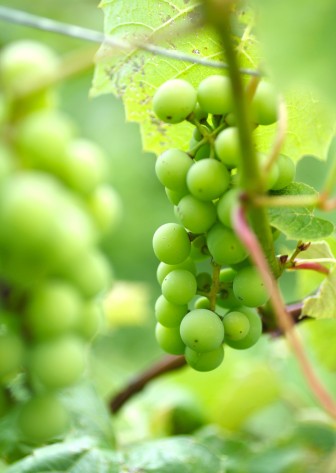
Bluebell grapes
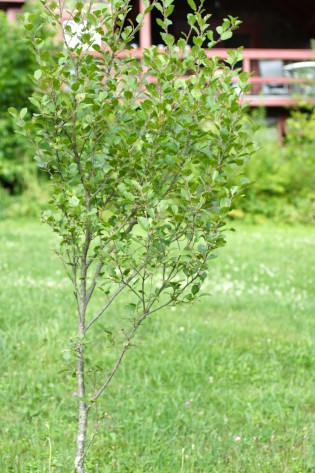
The Green Gage plus tree, a wisp of a tree still far from fruit-bearing stature
Yet is the only reason to do anything to benefit from the fruits of our labor? What about the enjoyment of the labor itself? Whereas subsequent owners of Dowdy Corners will get to enjoy the fruits of the three slow-growing apple trees we planted—“Bethel,” for its keeping ability and its name (the town next to us is called Bethel); “Dudley,” an old variety great for baking and making sauce; and “Sweet Sixteen,” an excellent eating apple described as being “spicy, sweet, and rich-flavored”—we enjoyed the fruits of four mature apple trees, one of which was, the apple pruning man said, about a hundred years old. This magnificent tree, with a hollowed out trunk, produces beautiful red apples variegated with green and yellow that were crisp, juicy, and good eating.
I looked up the word fruition in Merriam-Webster’s and was surprised to learn that the primary definition is “pleasurable use or possession: ENJOYMENT.” The second definition, which came into use in the nineteenth century, is the one most often used today: literally, “state of bearing fruit;” and figuratively, state of “realization” or “accomplishment.”
I like the older process- rather than goal-oriented meaning of term. In the old sense, every life project has the possibility of being brought to fruition before the next project begins, enabling us to more easily let go as transitions inevitably move us along. I hope the previous owners of Dowdy Corners felt the same way about fruition as they moved on—especially the person who planted the 100-year-old apple tree.
The sweet in this bittersweet move are the intangibles I take with me: the delights in watching honey bees light on arugula and broccoli flowers in the garden and in watching chickens leap in the air to catch a bug; a newfound comfort taken in the routines of tending, from the nightly task of locking up the chicken coop to the yearly fall application of sulfur and a pine-needle-and-peat-moss mulch to the blueberry bushes; a changed approach to dealing with food scraps (to not compost now seems utterly abnormal); a new appreciation for worms; the satisfaction found in the relationships borne of tending—the bees, the perennials, and particularly the chickens (sorry green beans, I liked taking care of you but you’re a one-season friend).
The tangibles aren’t bad either: jars of homemade canned pickles, soup, and greens, all made with produce from the garden; my favorite, very old garden tools; a wooden stick that has a few axe marks in its center (Mike has insisted upon keeping this artifact of a “Jennings” moment—when I lamely tried to chop the stick in half for kindling); and a pair of well-worn, Duct-tape wrapped Muck boots. The latter will be used next week when I head over to Fat Rooster Farm to help my friend Jenn with some farm chores, which give me visiting rights with Bob and will keep my refrigerator stocked with the quality of eggs I’d become accustomed to at Dowdy Corners.
**************************************************
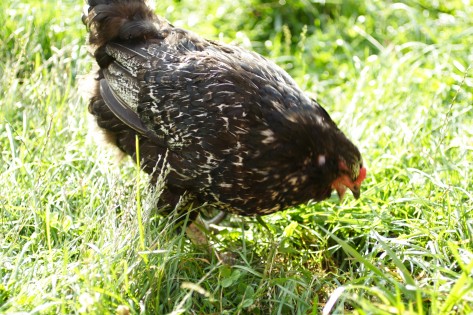
Fagin with her beak hanging open, a typical look for her
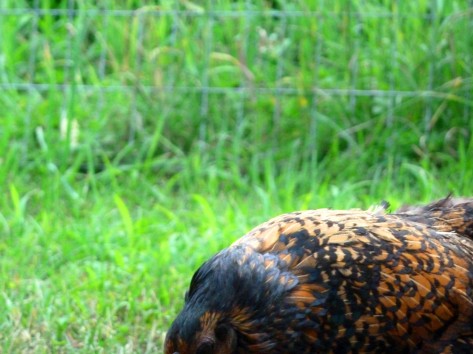
Waynetta’s plumage
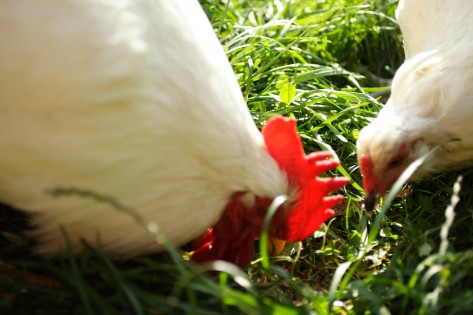
Bob and Dodger looking for good eats in the fresh green grass
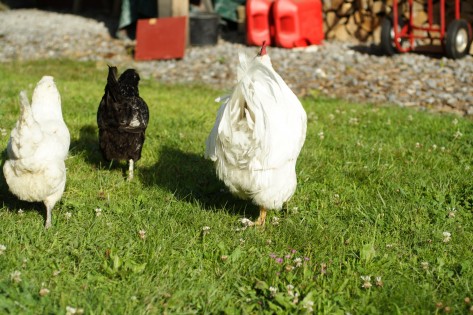
The chickens heading back to the coop. From the left: Dodger, Fagin, and Bob
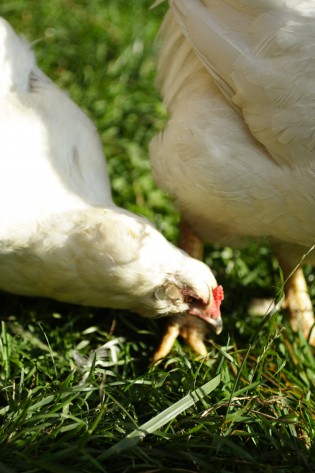
Dodger looking for food Bob has pointed out
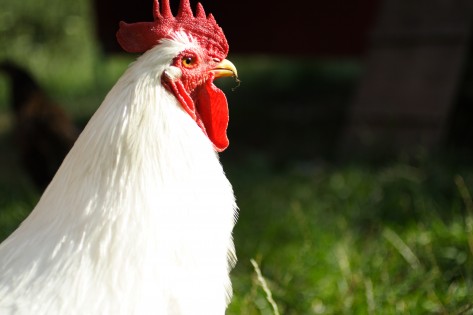
Bob in the evening light with a morsel hanging from his beak
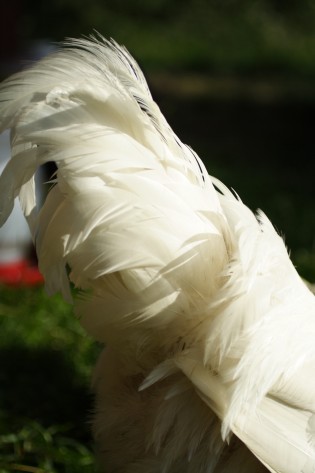
The magnificence of Bob’s tail
